The MID section is aligned at the top in Internet Explorer 11 on my machine -- using both your current CSS or what was originally posted.

However, there is a large amount of padding around the container -- which is a byproduct of browser rendering.
Since every browser and device can potentially apply tiny variances to how things are displayed, it can be extremely helpful, and less frustrating, to normalize the layout before applying any of your own styling.
For the most part, Normalizing is essentially the practice of removing browser presets and defining starting values in order to help standardize how everything is interpreted afterwards.
Here's my personal, normalize.css ...
/* ┌─────────────────────────────────────────────────────────────────┐
/* │ Normalize v1.1 │
/* │ Created by Dustin Halstead │
/* └─────────────────────────────────────────────────────────────────┘
/* ┌────────────────────────────────────────────────────────────────┐
/* │ Universal Adjustments │
/* 1. Correct line height in all browsers. */
/* 2. Prevent adjustments of font size after orientation changes in IE on Windows Phone and in iOS. */
* {
padding: 0;
margin: 0;
border: 0;
border-collapse: collapse;
vertical-align: baseline;
border-spacing: 0;
text-decoration: none;
line-height: 1.15; /* 1 */
-ms-text-size-adjust: 100%; /* 2 */
-webkit-text-size-adjust: 100%; /* 2 */
}
/* └────────────────────────────────────────────────────────────────┘
/* ┌────────────────────────────────────────────────────────────────┐
/* │ Sections │
/* Correct display in IE 9-. */
article, aside, footer, header, nav, section, figcaption, figure, main { display: block; }
/* Correct `h1` font size and margin within `section` and `article` areas in Chrome, Firefox, and Safari. */
h1 { font-size: 2em; margin: 0.67em 0; }
/* └────────────────────────────────────────────────────────────────┘
/* ┌────────────────────────────────────────────────────────────────┐
/* │ Grouping │
/* 1. Correct box sizing in Firefox. */
/* 2. Show overflow in Edge and IE. */
hr {
box-sizing: content-box; /* 1 */
height: 0; /* 1 */
overflow: visible; /* 2 */
}
/* 1. Correct inheritance and scaling of font size in all browsers. */
/* 2. Correct odd `em` font sizing in all browsers. */
pre {
font-family: monospace, monospace; /* 1 */
font-size: 1em; /* 2 */
}
/* └────────────────────────────────────────────────────────────────┘
/* ┌────────────────────────────────────────────────────────────────┐
/* │ Text │
/* 1. Remove the gray background on active links in IE 10. */
/* 2. Remove gaps in links underline in iOS 8+ and Safari 8+. */
a {
background-color: transparent; /* 1 */
-webkit-text-decoration-skip: objects; /* 2 */
}
/* Correct font weight in Chrome, Edge, and Safari. */
b, strong { font-weight: bolder; }
/* Correct the scaling and odd `em` font sizing in all browsers. */
code, kbd, samp { font-family: monospace, monospace; font-size: 1em; }
/* Correct font style in Android 4.3-. */
dfn { font-style: italic; }
/* Correct font size in all browsers. */
small { font-size: 80%; }
/* Prevent `sub` and `sup` elements from affecting the line height in all browsers. */
sub, sup { font-size: 75%; line-height: 0; position: relative; vertical-align: baseline; }
sub { bottom: -0.25em; }
sup { top: -0.5em; }
/* └────────────────────────────────────────────────────────────────┘
/* ┌────────────────────────────────────────────────────────────────┐
/* │ Embedded Content │
/* Add the correct display in iOS 4-7. */
audio:not([controls]) { display: none; height: 0; }
/* Hide overflow in IE. */
svg:not(:root) { overflow: hidden; }
/* └────────────────────────────────────────────────────────────────┘
/* ┌────────────────────────────────────────────────────────────────┐
/* │ Forms │
/* Remove the margin in Firefox and Safari. */
button, input, optgroup, select, textarea { margin: 0; }
/* Remove the inheritance of text transform in Edge, Firefox, and IE. */
button, select { text-transform: none; }
/* 1. Prevent a WebKit bug where (2) destroys native `audio` and `video` controls in Android 4. */
/* 2. Correct the inability to style clickable types in iOS and Safari. */
button,
html [type="button"], /* 1 */
[type="reset"],
[type="submit"] {
-webkit-appearance: button; /* 2 */
}
/* Correct the text wrapping in Edge and IE. */
legend { box-sizing: border-box; display: table; max-width: 100%; white-space: normal; }
/* Remove the default vertical scrollbar in IE. */
textarea { overflow: auto; }
/* Correct the cursor style of increment and decrement buttons in Chrome. */
[type="number"]::-webkit-inner-spin-button, [type="number"]::-webkit-outer-spin-button { height: auto; }
/* Correct the odd appearance in Chrome and Safari. */
[type="search"] { -webkit-appearance: textfield; }
/* Remove the inner padding and cancel buttons in Chrome and Safari on macOS. */
[type="search"]::-webkit-search-cancel-button, [type="search"]::-webkit-search-decoration { -webkit-appearance: none; }
/* Correct the inability to style clickable types in iOS and Safari. */
::-webkit-file-upload-button { -webkit-appearance: button; }
/* └────────────────────────────────────────────────────────────────┘
/* ┌────────────────────────────────────────────────────────────────┐
/* │ Interactive │
/* Correct display in Edge, IE, and Firefox. */
details, menu { display: block; }
/* Correct display in all browsers. */
summary { display: list-item; }
/* └────────────────────────────────────────────────────────────────┘
/* ┌────────────────────────────────────────────────────────────────┐
/* │ Miscellaneous │
/* Correct display in IE 9-. */
canvas { display: inline-block; }
/* Correct display in IE. */
template { display: none; }
/* Correct display in IE 10-. */
[hidden] { display: none; }
/* └────────────────────────────────────────────────────────────────┘
Give it a shot and see if it helps improve what you're seeing.
Hopefully, it'll prove to be of some use.
Update:
Realized that the layout was breaking during browser resizing more than the initial rendering.
The problem seems to be a direct result of including: display:-ms-grid;
... as well as a few positioning errors.
In addition, display: flex; needs to be defined in order for the content to flow correctly in the specified div.
.container {
position: absolute;
top: 0;
bottom: 0;
left: 0;
right: 0;
min-width: 270px;
background:cyan;
display: grid;
-ms-grid-columns: 1fr 1fr 1fr 1fr 1fr 1fr 1fr 1fr 1fr 1fr 1fr 1fr;
-ms-grid-rows: 1fr 1fr 1fr;
grid-template-columns: repeat(12, 1fr);
grid-template-rows: minmax(auto, auto);
}
.top {
min-height: 8em;
background: pink;
-ms-grid-column: 1;
-ms-grid-column-span: 12;
-ms-grid-row: 1;
grid-column: 1 / span 12;
grid-row: 1;
}
.mid {
min-height: 10em;
background: yellow;
-ms-grid-column: 1;
-ms-grid-column-span: 12;
-ms-grid-row: 2;
grid-column: 1 / span 12;
grid-row: 2;
display: flex;
}
.bottom {
min-height: 5em;
background: purple;
-ms-grid-column: 1;
-ms-grid-row: 3;
-ms-grid-column-span: 12;
grid-row: 3;
grid-column: 1 / span 12;
}
